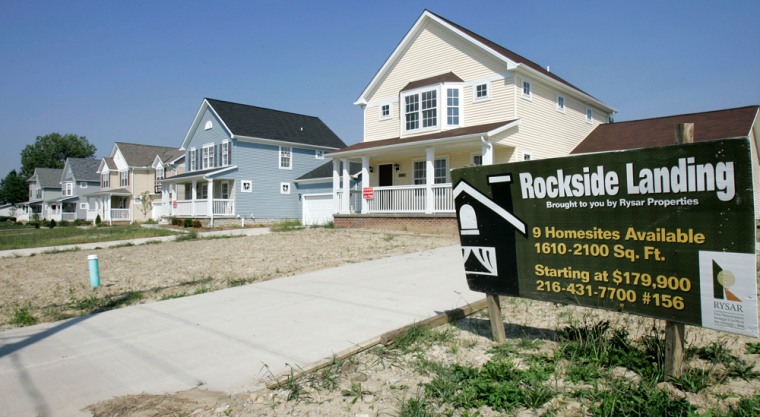This week’s half-point cut in interest rates by the Federal Reserve accomplished several important objectives, reassuring jittery financial markets by cutting the cost of money while demonstrating its determination to head off an economic downturn. But the move will have little short-term impact on the worst housing market in 16 years, which is at the root of the problem.
That was made clear in the latest report on the ailing industry, just a day after the rate cut, showing a sharp drop in housing starts last month to the slowest pace in 12 years.
"Housing starts have come down, at least in part, as a reaction by the home building industry to too much (unsold) inventory,” said Jerry Howard, CEO of the National Association of Home Builders.
Individual home builders say it’s too soon to know when conditions will begin to pick up again. On Tuesday, the NAHB reported that its index of builder confidence fell in September to the lowest level on record.
And while the Fed’s rate cuts may have provided a psychological boost to the markets, many analysts and builders think it will take more cuts — and more time — before the housing market recovers.
“Does anybody want to call this as a bottom because of the Fed cut?” said Robert Toll, CEO of home builder Toll Bros. at an investor conference Tuesday. “I don’t think you can call it yet.”
Some Wall Street investors seem to think the industry may have hit bottom; shares of many home builders surged Wednesday on news they have scaled back on new construction. The building slowdown in August is seen as a sign that a bulge in inventories of unsold homes may begin to shrink.
To cope with the inventory, builders have been slashing prices with some success. Hovnanian Enterprises, a builder with operations in 19 states, staged a nationwide sale last weekend, cutting prices by as much as 25 percent and offering some six-figure savings. The company said it sold 2,100 homes in one day — nearly as many as it sold in the three months ended July 31.
CEO Ara Hovnanian said Wednesday the company was "very thrilled" with the results and said the sale demonstrated that there are still plenty of buyers. But while he praised the Fed for providing an important psychological boost to consumers, Hovnanian says the housing market hasn’t bottomed yet.
“I expect housing starts to continue to come down in the coming months regardless of this rate cut," hee said. “There's a lot of momentum right now to slow the housing market down.”
Still, the Fed’s willingness to cut rates for the first time in four years may have helped prevent a further slide.
“We have a housing recession,” said Susan Wachter, a real estate professor at the Wharton School of Business. “This stops a housing depression.”
The move is also aimed at preventing the problems in the housing industry from broadening into a wider economic recession. Consumer spending, buoyed for years by the rapid rise in home prices, has begun to cool off.
Though auto sales have held up relatively well, that’s because fleet sales to corporations and rental car companies have offset weakness in consumer spending on cars, according to Michael Jackson, CEO of AutoNation, one of the country's largest car dealers.
“Once everybody figures out that the consumer has pulled back on big-ticket items, that brings the risk of recession into play,” he said. “I think that's what the Federal Reserve sees.”
Tuesday’s cut — double the quarter-point that many Fed watchers had expected — is a sign that Fed Chairman Ben Bernanke “understands that there is a psychological downward spiral, that a quarter-point wouldn’t break that downward spiral, and that it would take something like a half a point to do it," said Jackson.
But homeowners facing foreclosure will likely see little benefit from the Fed’s move. Many are already behind on adjustable mortgages that have reset from initial low “teaser” rates. The roughly 2 million homeowners who face resets this year and next will still see substantial jumps in their monthly payments. Borrowers who are locked into loans they can’t afford because of steep “prepayment” penalties won’t be helped by the Fed’s move.
And shoppers for new mortgages won’t catch much of a break. While short-term rates have moved lower as a result of the Fed’s cut, the market-based long-term rates that are used to price mortgages edged higher.
A lot depends on the Fed’s next move. In announcing the rate cut, the policymakers said they were keeping a watchful eye on inflation — which lower rates could make worse. Though the latest round of monthly data showed prices were fairly well in check, a recent jump in oil prices could erase those gains in the Fed’s fight to keep prices stable.
Stuart Hoffman, chief economist at PNC Financial Group, is in the camp that believes the short-term federal funds rate is headed as low as 4.25 percent by late this year or early next.
“They did start out boldly, but what really matters is the cumulative impact,” he said. “Much like you take an antibiotic, you are not going to feel better overnight. You are going to have to take a couple more doses, and I think this is just the first.”
